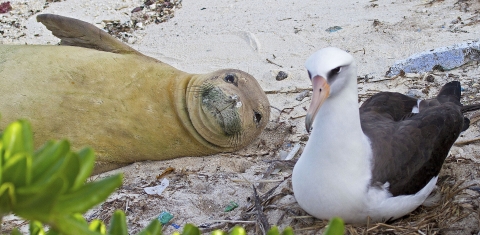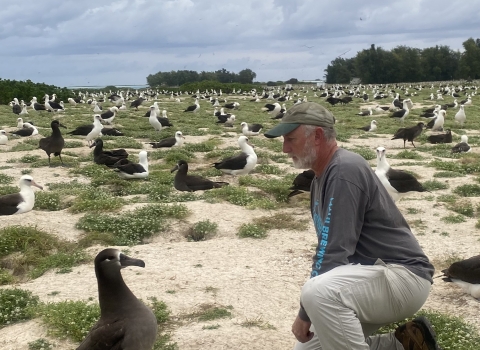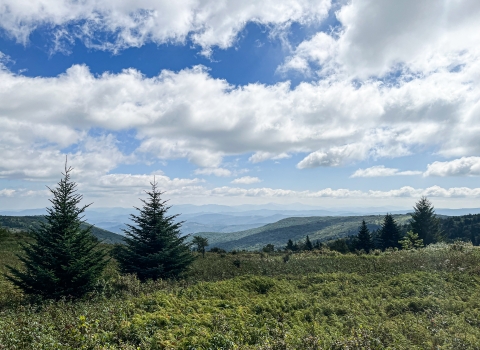The beach is a place to bask in the sun, relax to the rhythm of the surf and tune out for a while. If you tune in, though, there’s more than meets the eye: Piping plovers moving in and out with the waves. Crabs scurrying about. Sea turtle paths tracking to and from the ocean. And the sand itself.
“Sand is possibly something you take for granted,” U.S. Navy marine scientist Jessica Carilli has written. “It gets in your hair and your clothes and all over your food at the beach. But sand is also fascinating.”
Sand tells a story. Sand is composed of shells, rocks, corals and/or other materials that could be freshly deposited or perhaps have been pulverized by waves, wind and other natural forces for thousands or even hundreds of thousands of years.
“The sand on each beach is like a fingerprint — it’s unique to the particular beach where you find it,” former U.S. Geological Survey scientist Jeff Williams has said. “The sand’s unique composition, color and grain size are a result of the source rocks it came from.”
If sand is white — as at Alabama’s Bon Secour National Wildlife Refuge above — it likely contains a lot of quartz or calcareous material like shells and coral.
If sand is black — as at Alaska Maritime National Wildlife Refuge above — it probably is volcanic lava (basalt) that has been weathered for ages.
If it is green, as some beaches in Hawaii are, the mineral olivine is prevalent.
“Sand can be bio-geological, made up of once-living organisms,” says Honolulu-based U.S. Fish and Wildlife Service marine biologist Amanda Pollock. “It signifies the boundary between life and minerals.”
It can also blur that boundary. Some tropical white sand is formed when parrotfish ingest coral and poop it out as a sand cloud.
The Sand Atlas identifies about 20 categories of sand worldwide.
Sand-Dependent Animals and Plants
Beaches and the tidal zones just offshore are important to wildlife. Birds and animals rest, nest or feed in these sandy places, often at or near one of the nation’s 180 coastal or island national wildlife refuges.
Shorebirds — such as piping plovers, roseate terns, red knots, black skimmers and American oystercatchers along the East Coast and western snowy plovers and California least terns on the West Coast — depend on beaches.
Several species of sea turtles nest on sand.
Seals, sea lions, crabs, clams, scallops, sand dollars, starfish, worms, insects and microorganisms all rely on sandy beaches or tidal zones.
Carilli notes that various rays, skates and sharks feed over sand bottoms. Some use electrical sensing capabilities to find animals hidden in sand to eat.
Plants and insects found in beach sand dunes directly or indirectly support mammals, birds, reptiles, amphibians and pollinators. Dune vegetation is adapted to thrive in unstable ground, but the shifting sands make individual plants vulnerable to trampling. It’s important to tread lightly — or not at all — in and around dunes. Stay on established trails to keep the dunes healthy.
Two national wildlife refuges in California are known for impressive dunes. Guadalupe-Nipomo Dunes National Wildlife Refuge is in the heart of an 18-mile dunescape along the southern California coast northwest of Santa Barbara. In northern California, the restored dunes at Humboldt Bay National Wildlife Refuge feature a diverse range of native wildflowers.
Some coastal dunes protect people and property from storm surges.
Midway Atoll National Wildlife Refuge is home to 21 breeding seabird species — about 3 million individual birds — including Laysan, black-footed and short-tailed albatross, and Laysan ducks. Birds, Hawaiian monk seals and green sea turtles commonly frequent the atoll’s sandy beaches to rest or nest after often-long periods at sea.
Sandy Point National Wildlife Refuge on St. Croix in the U.S. Virgin Islands includes one of the most beautiful and unspoiled beaches in the Caribbean. The beach is also one of the world’s most important nesting sites for endangered leatherback sea turtles. During the April-to-August nesting season, the beach is closed to the public to protect the turtles. The rest of the year, the beach is open on weekends for residents and tourists to enjoy.
On the mainland, beaches at Archie Carr National Wildlife Refuge in Florida host the largest populations of loggerhead and green sea turtles in the United States. Cape Romain National Wildlife Refuge in South Carolina supports the nation’s largest population of loggerhead sea turtles outside Florida. And Kemp’s Ridley sea turtles depend on Aransas National Wildlife Refuge along the Gulf of Mexico in Texas.
Be a Responsible Beach-Goer
The beaches of the world — whether they are remote and deserted or nearby and teeming with people — are connected to one global ocean that covers more than 70 percent of Earth.
When at the beach, you can help protect the ocean and the critters that depend on it:
- Don’t litter. Leave the beach cleaner than you found it.
Properly dispose of all trash, especially plastic goods. Avoid releasing balloons. Don’t use plastic straws. If you leave those things behind, they become deadly to birds, turtles and marine life that often mistake plastic for food. - Give wildlife plenty of space.
Keep your distance from wildlife. Walk carefully to avoid harming animals or their nests. Don’t harass or feed wildlife. - Stay on trails and off closed beaches.
Doing so protects wildlife and, as noted above, fragile dune ecosystems. - Anglers, pack out all monofilament fishing line, hooks and loose packaging.
Fish, birds, marine wildlife and, occasionally, humans can be harmed when they are tangled in line, jabbed by hooks or swallow packaging. - Follow this Advice.
The marine wildlife-viewing guidelines compiled by the National Oceanic and Atmospheric Administration (NOAA) include several dos and don’ts of responsible beach behavior.











